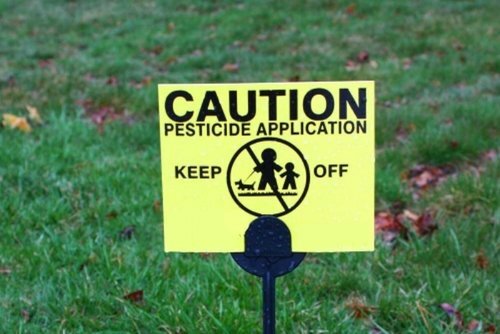Conventionally treated lawns are unsafe for children, pets and wildlife.
Traditional lawn care is toxic and wasteful
Nationwide, turf grass is estimated to cover over 40 million acres, an area three times larger than the amount dedicated to corn. Lawn and landscape care practices take up many resources as they rely on large amounts of synthetic fertilizers, pesticides, and water for maintenance.
These practices negatively affect the quality of life in our communities by degrading local waterways, polluting the air, harming pets and wildlife, contributing to climate change, and threatening human health.
For these reasons, many people, municipalities, and countries are transforming their lawns, parks, and public spaces by eliminating pesticides and using other sustainable lawn and landscape care practices.
Traditional lawn care has huge environmental costs.
It is misleading and a unfair to compare what the consumer pays for organic vs conventional lawn care. Homeowners use up to 10 times more chemical pesticides per acre on their lawns than farmers use on crops. Nearly 80 million pounds of pesticide active ingredients are used on U.S. lawns annually. On top of this, 90 million pounds of chemical fertilizers are used on lawns annually. Additionally, 26.7 million tons of air pollutants from mowing are introduced annually.
Americans spread over 90 million tons of toxic pesticides and fertilizers on our lawns each year.
Traditional lawn care disadvantages
Manufacturing & transportation environmental costs
Toxic to plants, insects, fungi and other soil microorganisms
Runoff affects waterways, sheds & a growing dead zone in the Gulf of Mexico
Provides limited nutrients
“Apply til you die”
“Downstream” costs paid by society
Herbicide resistance is happening
40 million acres of turf grass in U.S. (America’s largest irrigated crop)
Lawn account for 30% of residential water usage
Average American lawn is 1/3 acre and 54 million Americans mow their lawns each weekend
Lawn mowers consume over 800 million gallons of gasoline annually
In 1 hour, a lawn mower produces as much air pollution as driving a car for 100 miles
Nearly 90,000 tons of pesticides are used on U.S. lawns annually
Pesticides were found in “detectable levels” in 100% of river samples taken
Example of why traditional lawn care works poorly
After a homeowner sprays dandelions with herbicides the plants reproduce lots of seeds for next year’s crop
After a homeowner applies poison for grub damage the grass take up the poison. Grubs eat the grass roots and get poisoned. Birds and mammals eat the grubs poisoning the food chain. Lawn is still damaged
Join the natural lawn care movement.
Find more details on our Natural Lawn Care page.
Register for a Natural Lawn Care workshop




